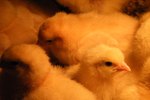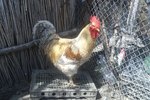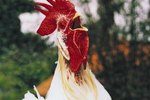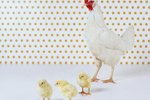
Your rooster's coxcomb will develop into one of his most distinctive physical features as he matures from chick to an adult. All roosters have coxcombs, though individual coxcomb shape and size vary depending on breed and unique genetic characteristics of the individual rooster. The coxcomb serves an aesthetic purpose as well as provides an indicator of your rooster's health.
The Coxcomb
The coxcomb, aka the comb, is located on top of the rooster's head. It is a red, fleshy growth. The comb and the wattle, which is the matching red growth underneath the rooster's chin, both serve the same general function and purpose.
Sexual Attraction
Your rooster uses his comb and wattle to help impress potential mates. Large, bright red combs and wattles are attractive to female hens. A rooster with a small comb or wattle may be less likely to attract the most desirable hens in the flock if competing roosters exist. Hens also have combs, but the combs are not as large as those on roosters. The purpose of hens' combs is the same in terms of blood flow and reproductive appeal.
Temperature Control
The coxcomb and the wattle are located on the top and the bottom of your rooster's head. The comb and the wattle help improve blood flow through the area. Increased blood flow helps the rooster cool his own body down when temperatures start to climb. A discolored comb can be a sign that your rooster is not healthy. Combs are especially prone to frostbite when the weather turns cold. If your rooster's comb is blue or black, call your veterinarian as soon as possible.
Comb Shape
The American Poultry Association lists nine possible comb shapes that roosters may have. These comb shapes include the single comb, the carnation comb, the pea comb, the buttercup comb, the cushion comb, the strawberry comb, the rose comb, the silke comb, the walnut comb and the V-shaped comb. Each comb has specific unique characteristics that designate its shape. Some combs, such as the cushion comb, are most common in specific breeds of chicken. Chantecler chickens have cushion combs.
References
- TBN Ranch: About Combs and Wattles, Chicken Anatomy
- Smithsonian Magazine: Why Roosters Have Wattles
- Oracle Think Quest: Anatomy
- National Department of Agriculture: Are My Chickens Healthy
- Amber Waves Silkies: The Importance of Combs and Wattles on Your Chickens
- Backyard Chickens: All About Chicken Combs – Single, Pea, Rose, V Shaped, Etc.
- University of Nevada: American Poultry Association Poultry Classifications
Photo Credits
-
Digital Vision./Digital Vision/Getty Images
Writer Bio
Jen Davis has been writing since 2004. She has served as a newspaper reporter and her freelance articles have appeared in magazines such as "Horses Incorporated," "The Paisley Pony" and "Alabama Living." Davis earned her Bachelor of Arts in communication with a concentration in journalism from Berry College in Rome, Ga.




